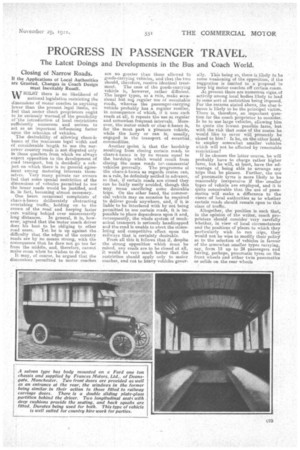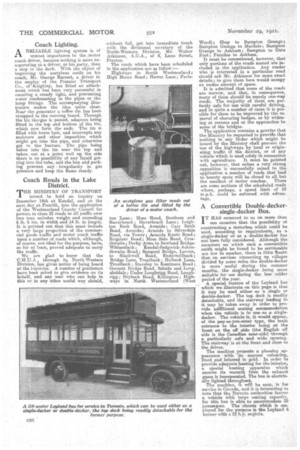PROGRESS IN PASSENGER TRAVEL.
Page 23

Page 24

If you've noticed an error in this article please click here to report it so we can fix it.
The Latest Doings and Developments in the Bus and Coach World.
Closing of Narrow Roads.
If the Applications of Local Authorities are Granted, Changes in Coach Design must Inevitably Result.
WHILST there is no likelihood of national legislation restricting the dimensions of motor coaches to anything lower than the present legal limits, We feel that motor chach proprietors ought to be seriously warned, of the possibility
of introduction of local restrictions sufficiently numerous and serious to act as an important influencing factor upon the selection, of vehicles. The desirabiliiy of allowing chars-kbanes of the maximum legal width and of considerable length to use the narrower country roads is not disputed only in those quarters from which we always expect opposition to the development of road transport, but is decidedly a subject on which there is no general agreement among motoring interests triemselves. Very many private car owners feel that some special restriction of the dimensions of vehicles permitted to use the lesser roads would be justified, and is, in fact, becoming almost necessary. One hears occasional complaints of chars-k-bancs deliberately obstructing overtaking traffic, holding on to the crown of the road and keeping faster cars waiting behind over unnecessarily
long distances. In general, it is, however; agreed that the motor coach driver does his best to be obliging to other road users. Yet he is up against the difficulty that the edges of the country roads are by no means strong, with the consequence that he dare not go too far from the middle, and, therefore, cannot make room when he wishes to do so.
It may, of course, be argued that the dimensions permitted, to motor coaches
are no greater than those allowed fo goods-carrying vehicles, and, that the two should, therefore, receive identical treatment. The case of the goods-carrying vehicle is, however, rather different.. The larger types, as a rule, make occasional but no regular use of unsuitable roads, whereas the passenger-carrying vehicle probably has a regular routine, 155 consequence of which, if it uses such roads at all, it repeats the use at, regular and somewhat frequent intervals. Moreover, the motor coach or char-a-bancs is, for the most part a pleasure vehicle, while the lorry or can is, usually, engaged in the transport of essential commodities.
Another ;point is that the. hardship resulting from closing certain roads to chars-k-bancs is by no means equal to the hardship which would result from closing the same roads tel. commercial vehicles generally. The programme oi the chars-k-banes as regards routes can, as a rule, be definitely settled in advance, so that, if certain roads are closed they can be fairly easily avoided, though this may mean sacrificing some desirable trips. On the other hand, the commercial vehicle may on occasion be required to deliver goods anywhere, and, if it is liable to be interfered with by not being permitted to use certain roads, it is impossible to place dependence upon it and, consequently, the whole system of meehanical transport is seriously handicapped and the road is unable to exert the stimulating and competitive effect upon the railways that is certainly desirable. From all this it follows that if, despite the strong opposition which must. be raised, any roads are to be closed at all, it would be very much better that the restriction should apply only to motor coaches, and not to heavy vehicles gerter
ally. This being so, there is likely to be some weakening of the opposition, if the suggestion is limited to a proposal to keep big motor coaches off certain -roads.
At present there are numerous signs, of activity among local bodies likely to lead to some sort. of restriction being imposed. For the reasons stated above, the char-Itbanes is likely to be the principal victim. There is, therefore, an important question for the coach proprietor to consider. Is he to use large vehicles, allowing him to quote the lowest possible fares, but with the risk that some of the routes he would like to cover will presently be closed to him?. Is he, on the other hand, to employ somewhat smaller vehicles which will not be affected by reasonable restrictions?
If be chooses the latter course, he will probably have to charge rather higher fares, but he will, at least, have the advantage of being able to arrange any trips that he pleases. Further, the use of pneumatic tyres is more likely to be reasonably inexpensive if the, smaller types of vehicle are employed, and it is quite conceivable that the use of pneumatics will make a difference to the views of local authorities as to whether certain roads should remain open to this class of traffic.
Altogether, the position is such that, in the opinion of the writer, coach proprietors should consider very carefully whether, in view of local circumstances and the positions of places to which they particularly wish to run rips, they would not be wise to modify their policy as to the selection of vehicles in favour of the somewhat smaller types carrying, say, from 15 up to 24 passengers and having, perhaps, pneumatic tyres on the front wheels and either twin pneumatics or solids on the rear wheels
Coach Lighting.
ARELIABLE lighting system is of utmost importance to the anotor coach driver, because nothing is more exasperating to a driver, or his party, than a stop in the dark. With the object of improving the acetylene outfit on his coach, Mr. George Barrett, a driver in the employ of the Premier Transport Co., of'Keighley, has fitted an attachment which has been very successful in ensuring a steady light, and preventing water condensating in the pipes or the lamp fittings. The accompanying illustration makes the idea quite clear. Near the generator a toffee tin has been strapped to the running board. Through the tin therga,s is passed, adapters being fitted in the top and bottom of the tin, which now form the ends. The tin is filled with horse hair, and intercepts any moisture and other impurities which might get. into the pipe, and otherwise get to the burners. The pipe being taken into the tin near the top and taken out at a point well up the side there is no possibility of any liquid getting into the tube, and the box and packing prevent any irregularity in gas pressure and keep the flame steady.
Coach Roads in the Lake District.
THE MINISTRY OF TRANSPORT intend to hold an inquiry on December 14th at Kendal, and on the next day at Penrith, into the application of the Westmorland County Council for powers to close 25 roads to all traffic over two tons unladen weight and exceeding 6 ft. 6 ins, in width and 14 ft. in length. It is pointed out that this must include a very large proportion of the commercial goods teaffic and motor coach traffic upon a number of roads which, although, of Course, not ideal for the purpose, have, so far at least, proved adequate to carry the traffic.
We are glad to know that the C.M.T.T.A., through its North-Western Division, has given notice of being heard at the iitquiries. A number of gentlemen have been asked to give evidence on its behalf, and any user who can help in this or in any other useful way should, without fail, get into immediate touch with the divisional secretary of the North-Western Division Mr. Walter Atkinson, A.C.A., of 9, Limo Street, Preston.
The roads which have been scheduled in the application are as follow:— Highways in South Westmorland; High House Road ; Hawes Lane; Earle
ton pane; Moss Road, Beetham and Ela,verbrack ; Ifaverbrack Lane; Leighton Beck Road, Arnside; Carr Bank Road, Arnside; Arnside to Silverdale Road, via Tower; Arnside Knott Road; Brigs teer Road; Moss Side Read, Orosthwaite ; Derby Arms to Rowland BridgeWitherslack ; Kendal-Sedgwick-Ackenthwaite Road; Sampool Bridge, Levens, to Blackwell Road, Endermillback; Bridge Lane, Troutbeck ; Holbeck Lane, Troutbeck ; Staveley to Kentmere Road; Garnett Bridge Road, Selside and Longsleddale ; Under Loughrigg Road, Loughrigg ; Drybeck Road, Killington ; Highways in North Westmorland (West
Ward); Shap to Bampton Grange; Bampton Grange to Mardale; l3ampten Grange to Askham; Bampton to Gate Foot; Fernilea to Askham.
It must be. remembered, however, that only portions of the roads named are included in the application. Any reader who is interestedin a particular road should ask Mr. Atkinson for more exact details to give them here would occupy an undue amount of space.
It is admitted that some of the roads are narrow, and that, in consequence, many of them should be merely one-way roads. The majority of them are perfectly safe for use with careful driving, and in quite a number of cases it is possible for them to be improved by the removaf of obscuring hedges, or by widening at corners and at the approaches to some of the bridges.
The application contains a proviso that the Ministry be requested to provide that nothing in any Order which might be issued by the Ministry shall prevent the use of the highways by local or originating traffic of the district, or of any vehicle which is used solely in connection with agriculture. It must be pointed out, however, that unless a very strong opposition is successfully raised to the application a number of roads that lead to beauty spots will be closed to all but the smallest of motor coaches. There are some sections of the scheduled roads where, perhaps, a speed limit of 10 m.p.h. could be enforced with advantage.
A Convertible Double-deckersingle-decker Bus.
TT HAS occurred to us on more than 1 one occasion that the possibility of constructing a motorbus which could be used, according to requirements, as a single-decker or as a double-decker has not been fully considered. Although the occasions on which such a convertible outfit might be found to be serviceable are few in number, there is little 'doubt that on services connecting up villages divided by some miles the double-decker is more useful 'during the slimmer months, the single-decker being more suitable for use during the less colder period of the year. A special feature of the Leyland bus which we illustrate on this page is that it may be used either as a si-nEle or double-decker. The top deck is readily detachable, and the stairway leading to it may be taken away in order to provide adffitional seating accommodation when the vehicle is in use as a singledecker. The vehicla. is, it would appear, of the pay-as-you-enter type, the main entrance to the interior being at the front on the off side (the English off side is the Canadian near-side). through a particularly safe and wide opening. The stairway is at the front and close to the driver.
The machine presents a pleasing apearance with its maroon colouring, lined and lettered in gold. In order to provide adequate heating for the interior, a special heating apparatus which secures its warmth from the exhaust gases is incorporated. The bus is electric
ally throughout.
The machine, it will he seen, is for service in Canada, and it is interesting to note that the Toronto authorities favour a vehicle with large seating. capacity, for this bus is able to accommodate 59 passengers. The chassis which is employed for the purpose is the Leyland 4 tonner with a 55 hp. enginie.
































